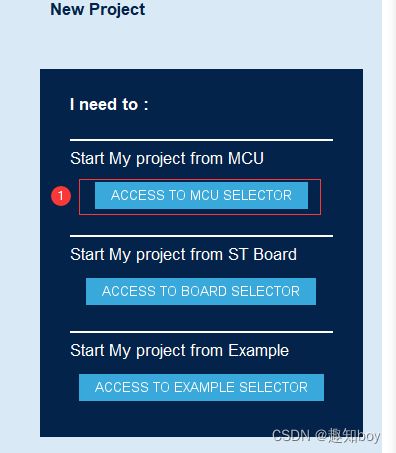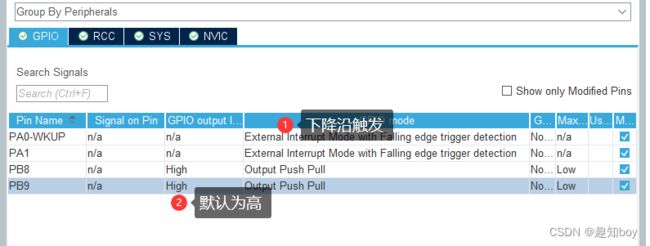STM32开发(CubeMX+HAL)——点灯(轮询、中断)
目录
1.CubeMX生成工程文件
2.点灯1——轮询
3.点灯2——中断
3.1CubeMX配置时钟
3.2中断和事件简介
3.3配置GPIO口
3.4使能中断
3.5配置工程
3.6中断函数编写
1.CubeMX生成工程文件
1.1新建工程
1.2输入STM32C8T6选择芯片
1.3双击芯片
1.4 选择System Core—SYS——Debug设置为Serial Wire
1.4点击引脚PA0、PA1设置为IO输入
PB8、PB9设置为输出引脚
1.5设置IO口的默认电平
将PB8、PB9的电平设置为默认高电平,不亮灯
1.6项目输出设置
注意:文件路径不能有中文-图中3路径是错误的案例。
1.7代码生成设置
1.8生成代码
1.9成功生成代码-打开代码
2.点灯1——轮询
1.User/Core下有main函数
2.在gpio口函数中可以看到如何对IO口进行操作
F12进入对应的函数段。
主函数F12 ——MX_GPIO_Init();——进入gpio相关函数
gpio函数F12——HAL_GPIO_Init——进入HAL-gpio函数相关操作
编写主函数:
这里都喜欢宏定义,不喜直接用数字
/* USER CODE BEGIN Header */
/**
******************************************************************************
* @file : main.c
* @brief : Main program body
******************************************************************************
* @attention
*
* Copyright (c) 2023 STMicroelectronics.
* All rights reserved.
*
* This software is licensed under terms that can be found in the LICENSE file
* in the root directory of this software component.
* If no LICENSE file comes with this software, it is provided AS-IS.
*
******************************************************************************
*/
/* USER CODE END Header */
/* Includes ------------------------------------------------------------------*/
#include "main.h"
#include "gpio.h"
/* Private includes ----------------------------------------------------------*/
/* USER CODE BEGIN Includes */
/* USER CODE END Includes */
/* Private typedef -----------------------------------------------------------*/
/* USER CODE BEGIN PTD */
/* USER CODE END PTD */
/* Private define ------------------------------------------------------------*/
/* USER CODE BEGIN PD */
#define Key_on 0
#define Key_off 1
/* USER CODE END PD */
/* Private macro -------------------------------------------------------------*/
/* USER CODE BEGIN PM */
/* USER CODE END PM */
/* Private variables ---------------------------------------------------------*/
/* USER CODE BEGIN PV */
/* USER CODE END PV */
/* Private function prototypes -----------------------------------------------*/
void SystemClock_Config(void);
/* USER CODE BEGIN PFP */
/* USER CODE END PFP */
/* Private user code ---------------------------------------------------------*/
/* USER CODE BEGIN 0 */
uint8_t Key_state(GPIO_TypeDef *GPIOx, uint16_t GPIO_Pin)
{
if(HAL_GPIO_ReadPin(GPIOx, GPIO_Pin)== GPIO_PIN_RESET){
//按键被按下
while(HAL_GPIO_ReadPin(GPIOx, GPIO_Pin)==0); //被按下时一直停在这里
return Key_on;
}else{
return Key_off;
}
}
/* USER CODE END 0 */
/**
* @brief The application entry point.
* @retval int
*/
int main(void)
{
/* USER CODE BEGIN 1 */
/* USER CODE END 1 */
/* MCU Configuration--------------------------------------------------------*/
/* Reset of all peripherals, Initializes the Flash interface and the Systick. */
HAL_Init();
/* USER CODE BEGIN Init */
/* USER CODE END Init */
/* Configure the system clock */
SystemClock_Config();
/* USER CODE BEGIN SysInit */
/* USER CODE END SysInit */
/* Initialize all configured peripherals */
MX_GPIO_Init();
/* USER CODE BEGIN 2 */
/* USER CODE END 2 */
/* Infinite loop */
/* USER CODE BEGIN WHILE */
while (1)
{
/* USER CODE END WHILE */
//HAL_GPIO_WritePin(GPIOB, GPIO_PIN_8|GPIO_PIN_9, GPIO_PIN_RESET);
if(Key_state(GPIOA, GPIO_PIN_0)==Key_on){
//按键被按下
HAL_GPIO_TogglePin(GPIOB, GPIO_PIN_8);
}
if(Key_state(GPIOA, GPIO_PIN_1)==Key_on){
//按键被按下
HAL_GPIO_TogglePin(GPIOB, GPIO_PIN_9);
}
/* USER CODE BEGIN 3 */
}
/* USER CODE END 3 */
}
/**
* @brief System Clock Configuration
* @retval None
*/
void SystemClock_Config(void)
{
RCC_OscInitTypeDef RCC_OscInitStruct = {0};
RCC_ClkInitTypeDef RCC_ClkInitStruct = {0};
/** Initializes the RCC Oscillators according to the specified parameters
* in the RCC_OscInitTypeDef structure.
*/
RCC_OscInitStruct.OscillatorType = RCC_OSCILLATORTYPE_HSI;
RCC_OscInitStruct.HSIState = RCC_HSI_ON;
RCC_OscInitStruct.HSICalibrationValue = RCC_HSICALIBRATION_DEFAULT;
RCC_OscInitStruct.PLL.PLLState = RCC_PLL_NONE;
if (HAL_RCC_OscConfig(&RCC_OscInitStruct) != HAL_OK)
{
Error_Handler();
}
/** Initializes the CPU, AHB and APB buses clocks
*/
RCC_ClkInitStruct.ClockType = RCC_CLOCKTYPE_HCLK|RCC_CLOCKTYPE_SYSCLK
|RCC_CLOCKTYPE_PCLK1|RCC_CLOCKTYPE_PCLK2;
RCC_ClkInitStruct.SYSCLKSource = RCC_SYSCLKSOURCE_HSI;
RCC_ClkInitStruct.AHBCLKDivider = RCC_SYSCLK_DIV1;
RCC_ClkInitStruct.APB1CLKDivider = RCC_HCLK_DIV1;
RCC_ClkInitStruct.APB2CLKDivider = RCC_HCLK_DIV1;
if (HAL_RCC_ClockConfig(&RCC_ClkInitStruct, FLASH_LATENCY_0) != HAL_OK)
{
Error_Handler();
}
}
/* USER CODE BEGIN 4 */
/* USER CODE END 4 */
/**
* @brief This function is executed in case of error occurrence.
* @retval None
*/
void Error_Handler(void)
{
/* USER CODE BEGIN Error_Handler_Debug */
/* User can add his own implementation to report the HAL error return state */
__disable_irq();
while (1)
{
}
/* USER CODE END Error_Handler_Debug */
}
#ifdef USE_FULL_ASSERT
/**
* @brief Reports the name of the source file and the source line number
* where the assert_param error has occurred.
* @param file: pointer to the source file name
* @param line: assert_param error line source number
* @retval None
*/
void assert_failed(uint8_t *file, uint32_t line)
{
/* USER CODE BEGIN 6 */
/* User can add his own implementation to report the file name and line number,
ex: printf("Wrong parameters value: file %s on line %d\r\n", file, line) */
/* USER CODE END 6 */
}
#endif /* USE_FULL_ASSERT */
3.点灯2——中断
- 配置时钟
- 配置GPIO口
- 使能中断
- 配置工程
3.1CubeMX配置时钟
作用:改变芯片的运行频率,频率高功耗大,速度快。
1.首先新建项目-找到芯片
SYS设置为Serial Wire
RCC中的High Speed Clock设置为Crystal/Ceramic Resonator
2.设置Clock Configration
3.2中断和事件简介
中断优先级中的级别
- 抢占优先级:高抢占可以打断低抢占
- 响应优先级:高响应不可以打断低响应
中断是软件级别的事
事件是硬件级别的事
EXTI初始化结构体:
typedef struct
{
//中断/事件线
uint32_t EXTI_Line; /*!< Specifies the EXTI lines to be enabled or
disabled.
This parameter can be any combination value
of @ref EXTI_Lines */
//EXTI 模式
EXTIMode_TypeDef EXTI_Mode; /*!< Specifies the mode for the EXTI lines.
This parameter can be a value of @ref
EXTIMode_TypeDef */
//触发类型
EXTITrigger_TypeDef EXTI_Trigger; /*!< Specifies the trigger signal active edge for
the EXTI lines.
This parameter can be a value of @ref
EXTITrigger_TypeDef */
//EXTI 控制
FunctionalState EXTI_LineCmd; /*!< Specifies the new state of the selected EXTI
lines.
This parameter can be set either to ENABLE or
DISABLE */
}EXTI_InitTypeDef;中断/事件线:
#define EXTI_Line0 ((uint32_t)0x00001) /*!< External interrupt line 0 */
#define EXTI_Line1 ((uint32_t)0x00002) /*!< External interrupt line 1 */
#define EXTI_Line2 ((uint32_t)0x00004) /*!< External interrupt line 2 */
#define EXTI_Line3 ((uint32_t)0x00008) /*!< External interrupt line 3 */
#define EXTI_Line4 ((uint32_t)0x00010) /*!< External interrupt line 4 */
#define EXTI_Line5 ((uint32_t)0x00020) /*!< External interrupt line 5 */
#define EXTI_Line6 ((uint32_t)0x00040) /*!< External interrupt line 6 */
#define EXTI_Line7 ((uint32_t)0x00080) /*!< External interrupt line 7 */
#define EXTI_Line8 ((uint32_t)0x00100) /*!< External interrupt line 8 */
#define EXTI_Line9 ((uint32_t)0x00200) /*!< External interrupt line 9 */
#define EXTI_Line10 ((uint32_t)0x00400) /*!< External interrupt line 10 */
#define EXTI_Line11 ((uint32_t)0x00800) /*!< External interrupt line 11 */
#define EXTI_Line12 ((uint32_t)0x01000) /*!< External interrupt line 12 */
#define EXTI_Line13 ((uint32_t)0x02000) /*!< External interrupt line 13 */
#define EXTI_Line14 ((uint32_t)0x04000) /*!< External interrupt line 14 */
#define EXTI_Line15 ((uint32_t)0x08000) /*!< External interrupt line 15 */
#define EXTI_Line16 ((uint32_t)0x10000) /*!< External interrupt line 16
Connected to the PVD Output */
#define EXTI_Line17 ((uint32_t)0x20000) /*!< External interrupt line 17
Connected to the RTC Alarm event */
#define EXTI_Line18 ((uint32_t)0x40000) /*!< External interrupt line 18
Connected to the USB OTG FS Wakeup from suspend event */
#define EXTI_Line19 ((uint32_t)0x80000) /*!< External interrupt line 19
Connected to the Ethernet Wakeup event */
#define EXTI_Line20 ((uint32_t)0x00100000) /*!< External interrupt line 20
Connected to the USB OTG HS (configured in FS) Wakeup event */
#define EXTI_Line21 ((uint32_t)0x00200000) /*!< External interrupt line 21
Connected to the RTC Tamper and Time Stamp events */
#define EXTI_Line22 ((uint32_t)0x00400000) /*!< External interrupt line 22
Connected to the RTC Wakeup event */EXTI模式:
typedef enum
{
EXTI_Mode_Interrupt = 0x00, //产生中断
EXTI_Mode_Event = 0x04 //产生事件
}EXTIMode_TypeDef;触发类型:
typedef enum
{
EXTI_Trigger_Rising = 0x08, //上升沿
EXTI_Trigger_Falling = 0x0C, //下降沿
EXTI_Trigger_Rising_Falling = 0x10 //上升沿和下降沿都触发
}EXTITrigger_TypeDef;EXTI控制:
使能 EXTI ,一般都是使能, ENABLE
FunctionalState EXTI_LineCmd; 设置为ENABLE
中断优先级设置
STM32通过中断控制器NVIC(Nested Vectored Interrupt Controller)进行中断的管理 。
NVIC是属于Cortex内核的器件,不可屏蔽中断(NMI)和外部中断都由它来处理,但是SYSTICK
不是由NVIC控制的。
typedef struct
{
uint8_t NVIC_IRQChannel;
uint8_t NVIC_IRQChannelPreemptionPriority; //抢断优先级
uint8_t NVIC_IRQChannelSubPriority; //响应优先级
FunctionalState NVIC_IRQChannelCmd;
} NVIC_InitTypeDef;3.3配置GPIO口
SYS、RCC和之前一样的设置
PA0和PA1设置为外部中断
PB8、PB9设置为输出端口
3.4使能中断
NVIC中使能中断打开
3.5配置工程
Project和Code Generator 和以前一样的设置
记得Toolchain/IDE也要改为MDK-ARM,图中是错误示范
然后Generate Code然后打开
3.6中断函数编写
void HAL_GPIO_EXTI_Callback(uint16_t GPIO_Pin)
{
switch(GPIO_Pin){
HAL_Delay(50);
case GPIO_PIN_0:
if(HAL_GPIO_ReadPin(GPIOA, GPIO_PIN_0)==GPIO_PIN_RESET){
HAL_GPIO_TogglePin(GPIOB, GPIO_PIN_8);
}
break;
case GPIO_PIN_1:
if(HAL_GPIO_ReadPin(GPIOA, GPIO_PIN_1)==GPIO_PIN_RESET){
HAL_GPIO_TogglePin(GPIOB, GPIO_PIN_9);
}
break;
}
}在main.c——USER CODE BEGAIN中编写中断函数。


















